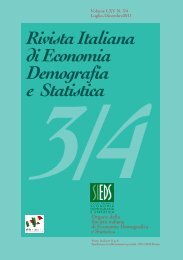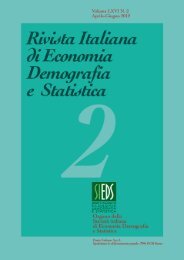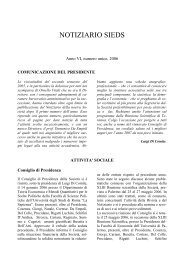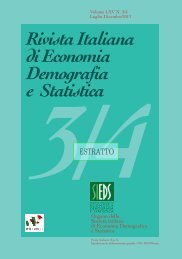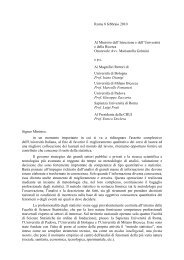rivista italiana di economia demografia e statistica - Sieds
rivista italiana di economia demografia e statistica - Sieds
rivista italiana di economia demografia e statistica - Sieds
Create successful ePaper yourself
Turn your PDF publications into a flip-book with our unique Google optimized e-Paper software.
60<br />
Volume LXIII nn. 3-4 – Luglio-Dicembre 2009<br />
Table 2 – Tenure status <strong>di</strong>stribution and average rent at market price at PPP by Country.<br />
Tenure status<br />
Tenants below<br />
Tenants at<br />
the market price<br />
Country<br />
Dwelling market price<br />
or in a<br />
owners and (average<br />
subsi<strong>di</strong>zed<br />
rent)<br />
market<br />
Free tenants<br />
IT 72.1 13.6 (363 €) 4.8 9.5<br />
ES 81.0 8.7 (470 €) 2.5 7.8<br />
FR 60.2 12.1 (440 €) 23.4 4.3<br />
UK 72.0 13.2 (502 €) 13.6 1.2<br />
We turn now to analyze the effects on overall poverty and inequality. In table 3<br />
poverty in<strong>di</strong>cators (at risk of poverty rate and me<strong>di</strong>an at risk of poverty gap) and<br />
concentration index (Gini index) are shown 3 . Taking the <strong>di</strong>sposable income net of nonmonetary<br />
components as a baseline case, the inclusion of IR causes a general reduction<br />
in inequality indexes. Regardless the percentage of households at risk of poverty, we<br />
can observe a decrease of this share by ad<strong>di</strong>ng the figurative income, more marked for<br />
Spain. Italy becomes the Country with the highest incidence (16% of the households),<br />
similar to UK, while FR shows the lowest figures in both cases. Moreover, Italy is the<br />
unique Country where the intensity of poverty, measured by the me<strong>di</strong>an at risk of<br />
poverty gap, increases.<br />
Table 3 also shows that inequality, measured through the Gini index, decreases<br />
when IR is computed in the household income. The highest decrease is in ES, while the<br />
lowest is in FR; nonetheless, FR is the Country with the least income concentration in<br />
both case, while UK, accor<strong>di</strong>ngly with literature on income <strong>di</strong>stribution, remains the<br />
most unequal Country. Two are the general effects of IR on inequality measures. On<br />
one side, it enlargers the <strong>di</strong>fferences in income between market tenants and the other<br />
subgroups; on the opposite, since the <strong>di</strong>stribution of IR is less <strong>di</strong>spersed than monetary<br />
income, it reduces the total inequality among the population: for many dwelling owners<br />
in the lowest tail of income <strong>di</strong>stribution the house is the largest asset and the IR income<br />
is a larger proportion of the household income in respect of the households in the upper<br />
tail of the <strong>di</strong>stribution (Istat, 2008; Abs, 2008). This result is in line with several stu<strong>di</strong>es<br />
on IR, such D’Ambrosio and Gigliarano (2007), Marical et al. (2006) and Frick and<br />
Grabka (2003).<br />
The above results show the overall effects of IR. Decomposing the population, i.e.<br />
by tenure status or by the age of the dwelling responsible, there are relevant <strong>di</strong>fferences<br />
between the subgroups, with a general improvement of the relative position for<br />
3 The results for income without inclu<strong>di</strong>ng IR are about in line with the ones in the Eurostat<br />
website. Differences are due to the households dropped for missing variables of interest.



